Saint Julien 2018
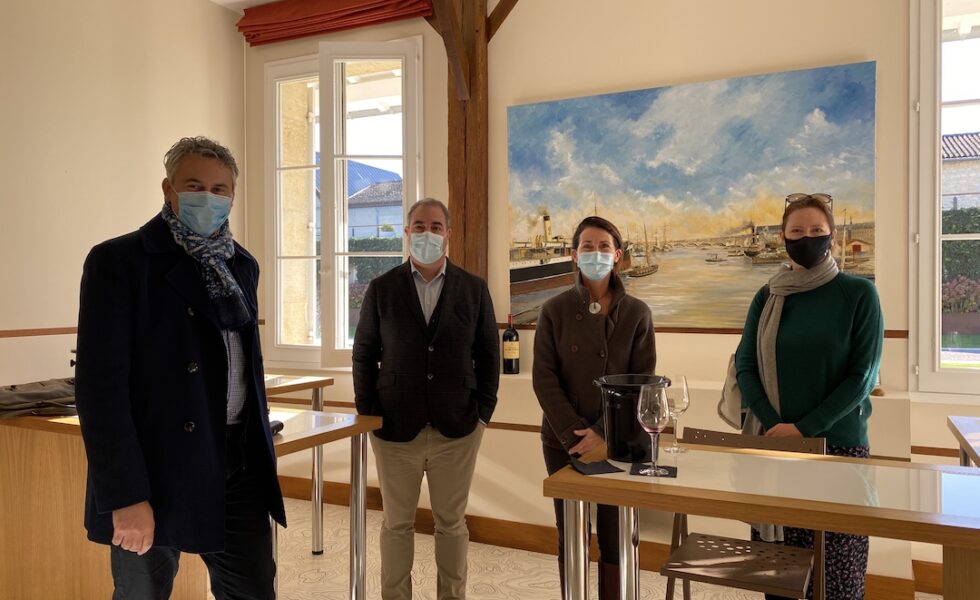
Consistent excellence
By Panos Kakaviatos for wine-chronicles.com
24 January 2021
Consistently excellent in 2018, recently bottled wines from this appellation fulfill their promise from barrel: elegant, suave, sometimes powerful, with grip, but overall refined and fresh. I give an edge to the 2016 vintage for superior freshness, as Didier Cuvelier of Château Léoville Poyferré agrees. Still, 2018 could win on palate density in some cases. Another reflection of success were the consistently good second wines of the classified growths, when tasted blind with Jane Anson and Yohan Castaing. For sheer affordability, special mentions to Pavillion de Léoville Poyferré and Connetable de Talbot, each about $30/€30 retail. The First Wines were tasted blind at Château Léoville Poyferré. But Château Léoville Las Cases was tasted at the estate, not blind, just next door. Tasted outside this series, Las Cases (and Clos du Marquis) come at the end.
As usual, when in bold, I liked especially. If red and bold, even more. If underlined, too? A kind of wine nirvana.
First Wines 2018 in bottle
Château Beychevelle – Deep and dark fruit aromas. The palate has opulence, but today just a bit tightly wound up, but in a good way! There is notable power on this wine, which impresses me. Maybe a hint of heat that recalls the expression “fire in the belly”. Not quite the same high level of finesse one gets from 2016, mind you. But going back to it, you do get elegance and refinement … tout de même! A wonderful Beychevelle in the making! 95+
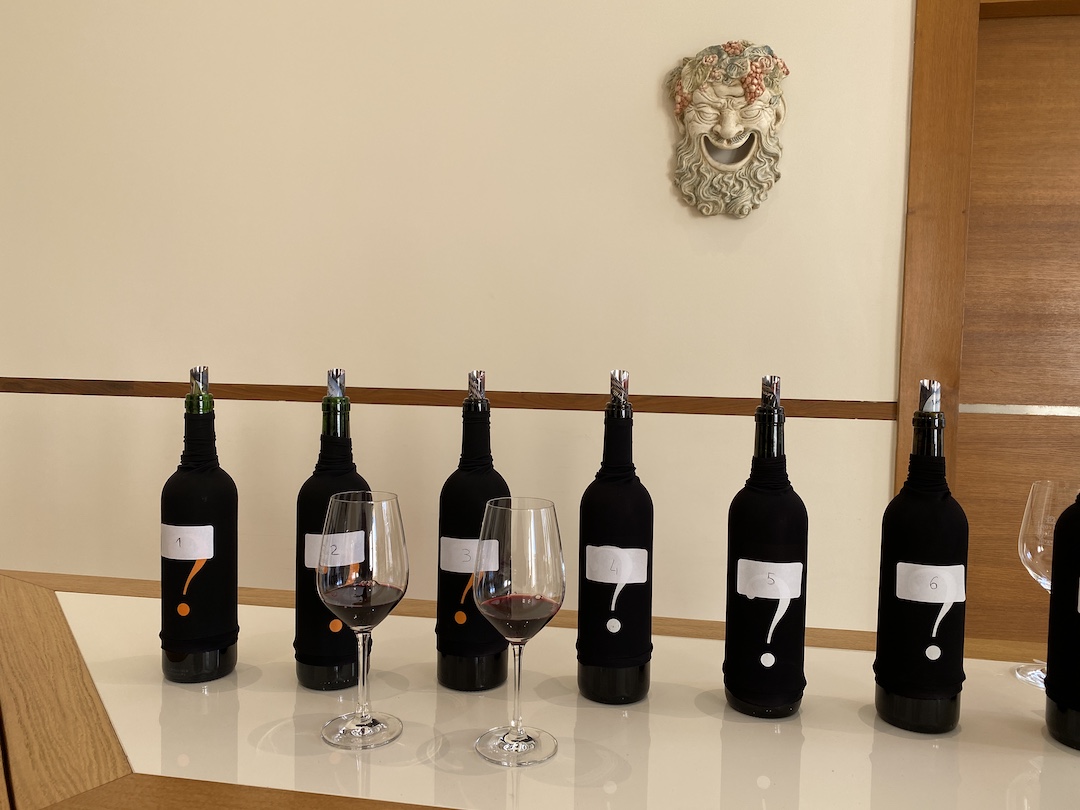
The joke is on you, when tasting blind.
Château Saint Pierre – Subtle aromatic expression here but within 10 minutes of aeration it yields juicy blackberry, plum and blackcurrant. Tobacco, too. The palate has depth, but even tighter than in the preceding wine. That said, the fire in the belly aspect not as strong, although you get a sense of high 2018 octane. There is a sense on the palate of tasting the skins from a ripe grape, with power behind them, and tannins that are very ripe and present. In the end, this just needs time in a carafe. Great potential. Long finish. 94
Château Talbot – Again a rather closed in nose. Somewhat steely. Burgeoning crushed tobacco. And palate juiciness, but a foreboding aspect as if we were in Pauillac rather than Saint Julien. Acidity balances the alcohol, as is the case with preceding wines, but I get a higher tone here. Does it come across somewhat disjointed and abrupt on the finish? To some extent, but fine quality tannin means that cellaring will makes things better. I’ll be conservative in my note, however. 92+
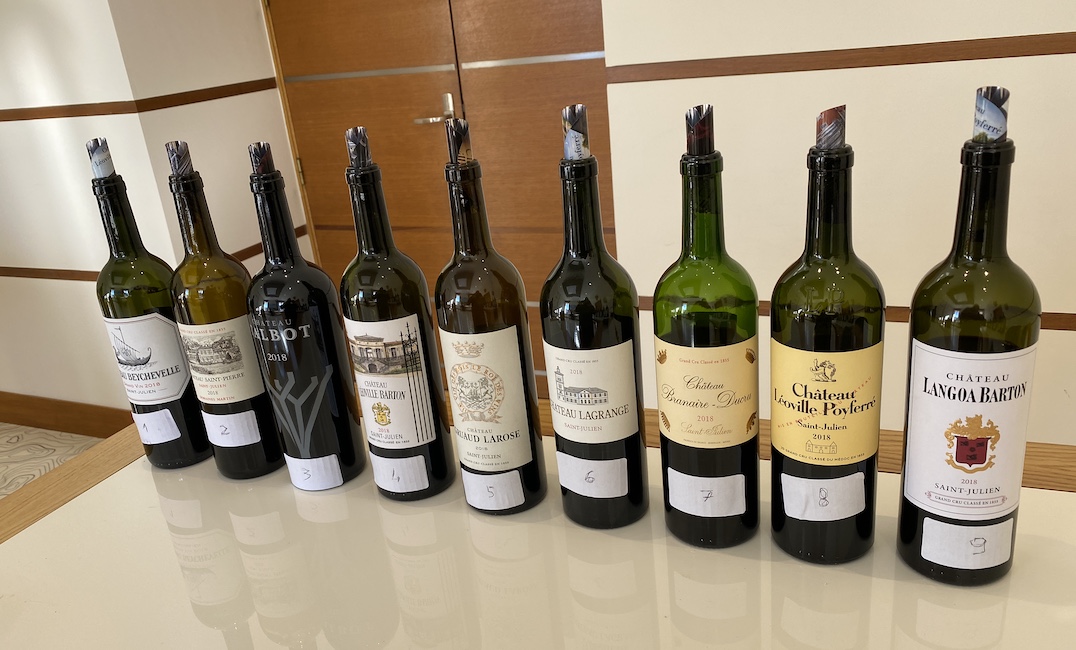
That new Talbot label stands out.
Château Léoville Barton – When the bottle was unveiled, I was not surprised by the power of this estate. Sure, the aromas are more evidently welcoming than the preceding wine, and it reminded me of the 2009 en primeur: warmer ripe fruit from a solar vintage, but without being “modern”. In 2018, Léoville Barton exudes familiar tannic edge, blending 82% Cabernet Sauvignon with 18% Merlot, and a rather foreboding sense more like Pauillac. Returning to the nose, reassuringly Saint Julien, with lovely, floral aspects. Aged in 60% new oak, and alcohol clocks in at 14.1% Seriously Saint Julien. 96
Château Gruaud Larose – Lovely, deep aromatics, vivid floral expressions, both violets and spring white, ripe dark fruit, with much freshness. Finesse and power on the palate, too, with notable tannic edge sans the “fire” which can be a sign of 2018. Overall a very successful Saint Julien: both elegance and almost steely power. The wine blends 61% Cabernet Sauvignon, 29% Merlot, 7% Cabernet Franc and the rest Petit Verdot. Aged in 80% new oak, it clocks in at 14.2% alcohol. The fabulous deep gravels of the estate combined with cooler clays maintaining freshness contribute to the success. 96
Château Lagrange – Lighter expression of white flower on the nose, not as violet and deep as the preceding wine. It is more, well, dainty in expression. There is visceral energy to the palate as it has more noticeable acidity in a good way, as the ripe fruit and tannin make for a high wire act. More “high toned”, that needs time to settle down. Not modern. Nice, but I have a feeling that the 2019 is better! 94

Evelyn and François-Xavier Maroteaux of Château Branaire Ducru
Château Branaire-Ducru – Fine aromatics: white flower, blackberry and lead pencil. Suave palate with spherical elegance, perhaps a bit of standoffish tannin, but overall much to love. Cellaring will reap rewards, as already smooth, but the tannins need some taming. The finish includes cool tobacco leaf notes. I went to the estate and tasted the 2019, which seems even better! One thing is certain: for the price, you get great wine from this estate. 94+
Château Léoville Poyferre – Here a wine whose numbers could eventually worry: it clocks in at 14.6% alcohol. But this blend of 62% Cabernet Sauvignon, 33% Merlot, 3% Cabernet Franc, 2% Petit Verdot also has balancing acidity (pH 3.66) and exudes refined dark, ripe fruit aromas along with coco powder, and even a sweet nougat aspect and some barrel influence. It was aged in 80% new oak, and that makes for fine seasoning and not the main event. And the palate has richness and depth, with a “streamlined feel” that indicates structure in a velvety tannin expression, with power and grace. Now the big question: How will it compare over the years with the 2016? 96
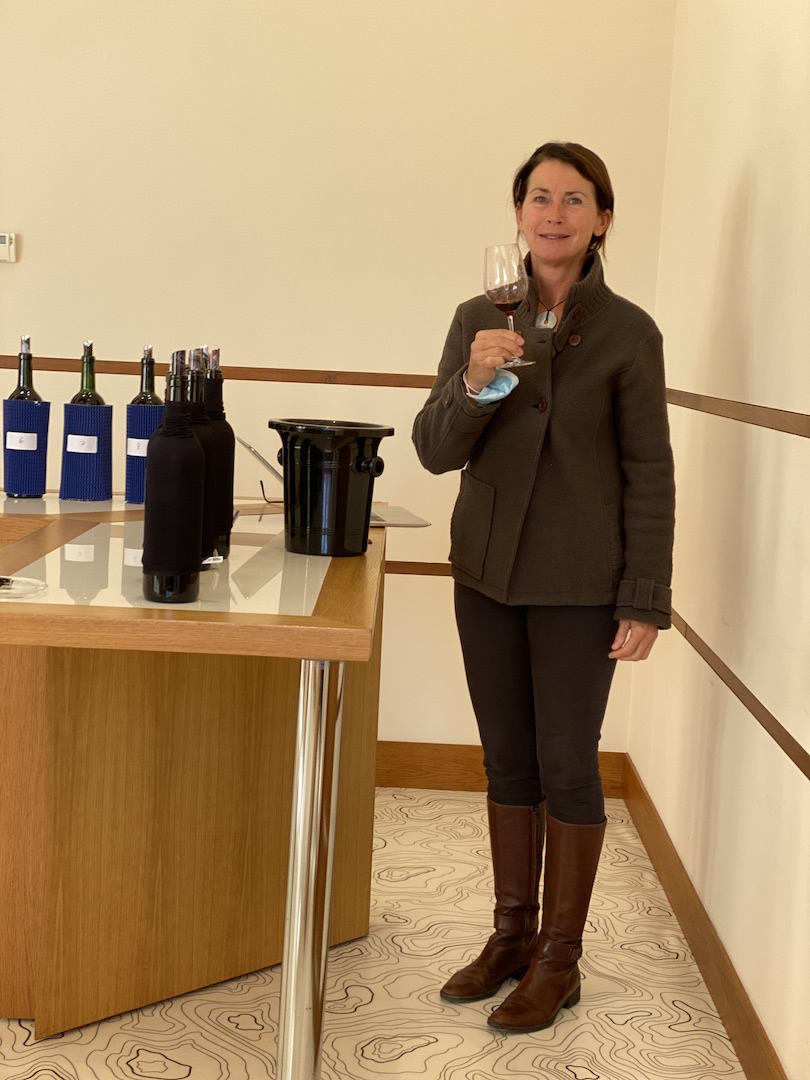
Sara Lecompte Cuvelier of Château Léoville Poyferré
Château Langoa Barton – Excellent expression of ripe fruit, pleasing white pepper and hints of coco powder. The palate conveys freshness and verve albeit with ripe, inviting fruit. There is mid palate sap that pleases the palate, which also exudes tannic grip, but never leaving the impression of structure over ripe fruit. Nice! 94
At Château Léoville Las Cases
Clos du Marquis – In case readers are not aware: Clos du Marquis is not the second wine of Château Léoville Las Cases. Indeed, its more gravely terroir – located slightly to the west – was never part of the old Domaine de Léoville property register (cadastre) in the first place. In any case, from barrel, I recall having heard that the estate suffered more than Léoville Las Cases from the dry heat of the vintage, as Las Cases has deeper clays, but in bottle the nose is brighter than from barrel! And the palate exudes ripe cassis and pristine graphite that makes the taster appreciate all the efforts put into this wine to make it special. Given the average age of vines at 30 (as opposed to 50 at Las Cases), this property will only get better. The alcohol, at 14.5%, is again is very well integrated for the balance. Excellent. 95
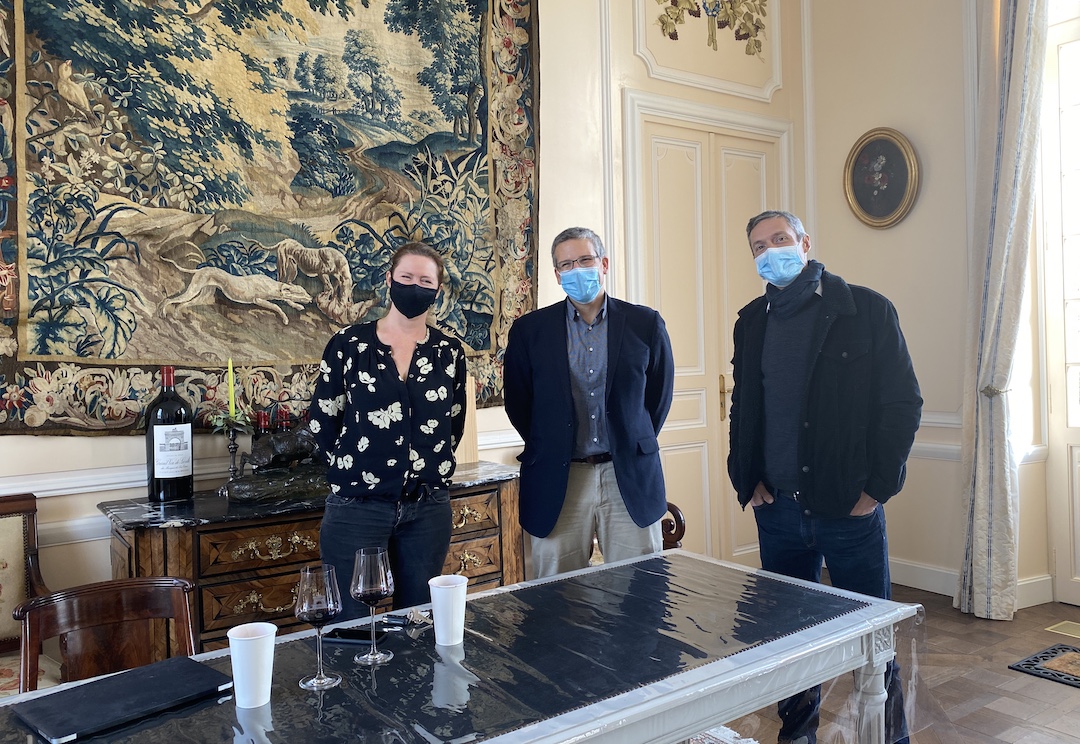
Jane Anson with Pierre Graffeuille and Antoine Gimbert of Château Léoville Las Cases
Château Léoville Las Cases* – Think of Cohiba Esplendido – or another top cigar – and here it is, on the nose. The wine takes the best characteristics of 2018 – veritably opulent and dense – but includes much impressive finesse and elegance and delectable sap. Sure, full body, but never too much, ending with pristine, precise and persistent length. In short, a Top Ten bottle of 2018, with (stiff) competition from the First Growths (all re-tasted except for Latour). Yet more proof that Las Cases qualifies for First Growth status. 2018 easily rivals the superb 2016. While tasting from barrel last year, director Pierre Graffeuille mused that the concentration was such – typically the estate uses about 10% press wine, but only 2.3% was used to make the 2019 – that he considered aging the wine in oak longer than usual, up to 20 months. But fears of too much oak tannin extraction from rather high alcohol wine, clocking in at just under 14.5%, led them to stick with 18 months aging. Indeed, remarkable freshness, too, for this vintage. 99
Second Wines 2018 in bottle
Amiral de Beychevelle (Second wine of Château Beychevelle): Forest strawberry, bright fruit aromas. Fine depth on the palate, with subtle richness and some elegance. The acidity is rather present here, with a lively, medium+ finish. Somewhat high toned, but get that uncorked for your steak! 89
Fiefs de Lagrange (Second wine of Château Lagrange): Nose not as expressive here, when compared to the preceding wine. Deep, dark ripe fruit on the nose. The palate has some gum puckering astringency puckering, but it “delivers the goods” for grilled meats or rich cheeses. 86+
Reserve de Léoville Barton (Second wine of Château Léoville Barton): Dark rich fruit and chocolate cake make up some of the aromas here, but the wine needs at least 30 minutes in glass to show its charms. The palate comes across a bit steely and tight, so decanting is needed to appreciate the brighter fruit notes leading to a medium finish. 87
Sarget de Gruaud (Second wine of Château Gruaud Larose): Steely as well. Lacking seduction and that inviting Saint Julien quality. Lots of tannin, but where is the fruit? This is even steelier than the preceding wine, and my least favorite among these second wines. Note reserved.
Pavillon de Léoville Poyferre (Second wine of Château Léoville Poyferré): “Finesse in floral aspects” were the words that came to mind, as I smelled the wine. Quite distinct coco powder over fine cappuccino, too. The palate is rather warm, reflecting perhaps the vintage nature, yet with fine grip and thus counts as my second overall favorite for these second wines. Medium plus finish and bright as well. Bravo! 90
Esprit Saint Pierre (Second wine of Château Saint Pierre): Fresh floral and blue fruit aspects. Touch of coco powder. The palate is a tad austere, a tad steely, but it opens up with time in glass. I like its reassuring tannic edge that bodes well for aging. 89
Connetable de Talbot (Second wine of Château Talbot): What a lovely floral and cassis infused aroma, which precedes a palate with tannic edge but refined in expression. Even more “foreboding” in nature than the preceding wine, but really in a good way as the fruit is clearly bright and ripe and aging will tame all that. 90
Category: Blog Tagged: Beychevelle, Branaire Ducru, Clos du Marquis, Gruaud Larose, Lagrange, Léoville Barton, Léoville Las Cases, Léoville Poyferré, Saint Julien, Saint Pierre, Talbot
2 Comments on “Saint Julien 2018”
Leave a Reply to admin Cancel reply
This site uses Akismet to reduce spam. Learn how your comment data is processed.
 Wine Chronicles
Wine Chronicles
Lovely review, thank you. No tasting of Ducru?
Thanks for reading Jim! Did not get to it…